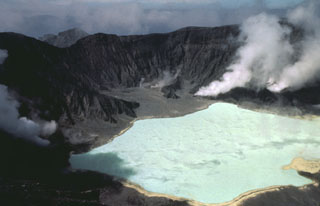Report on El Chichon (Mexico) — September 1982
Scientific Event Alert Network Bulletin, vol. 7, no. 9 (September 1982)
Managing Editor: Lindsay McClelland.
El Chichon (Mexico) Small phreatic explosion; little northward movement of stratospheric cloud
Please cite this report as:
Global Volcanism Program, 1982. Report on El Chichon (Mexico) (McClelland, L., ed.). Scientific Event Alert Network Bulletin, 7:9. Smithsonian Institution. https://doi.org/10.5479/si.GVP.SEAN198209-341120
El Chichon
Mexico
17.3602°N, 93.2297°W; summit elev. 1150 m
All times are local (unless otherwise noted)
A small ash ejection, lasting only a few minutes, occurred on 11 September, the first eruptive activity reported since minor ash emission stopped in early May. Instruments near the volcano recorded a slight increase in seismicity beginning 26 August, to a few very small events per day, and seismic activity remained at this level through late September. There have been no reports or evidence of lava dome extrusion (a large summit dome was destroyed by the March-April explosions). By September, the three lakes that covered much of the crater floor after the March-April explosions had coalesced into two larger lakes. Heavy rains have washed out most of the roads near the volcano and have made field work extremely difficult. In late October, after the end of the rainy season, geologists will climb the volcano and sample gases.
Residents of the municipio of Francisco León, destroyed by a pyroclastic flow 4 April, estimate that about 400 people in the area were killed by the eruption, and the Catholic diocese of Tuxtla Gutiérrez has a list of more than 1,000 persons believed to have died. The eruption was also reported to have killed most of the birds near the volcano. As a result, insects multiplied and devoured crops planted at the beginning of the rainy season, leaving many farmers without food. Coffee, which normally provides a cash crop, survived the eruption but appears unlikely to produce any beans in 1982. The Mexican government has resettled people from heavily damaged villages onto land in other parts of the state of Chiapas. By the end of July, few of the 60,000 refugees from the eruption remained in temporary camps.
Geological Summary. El Chichón is a small trachyandesitic tuff cone and lava dome complex in an isolated part of the Chiapas region in SE México. Prior to 1982, this relatively unknown volcano was heavily forested and of no greater height than adjacent non-volcanic peaks. The largest dome, the former summit of the volcano, was constructed within a 1.6 x 2 km summit crater created about 220,000 years ago. Two other large craters are located on the SW and SE flanks; a lava dome fills the SW crater, and an older dome is located on the NW flank. More than ten large explosive eruptions have occurred since the mid-Holocene. The powerful 1982 explosive eruptions of high-sulfur, anhydrite-bearing magma destroyed the summit lava dome and were accompanied by pyroclastic flows and surges that devastated an area extending about 8 km around the volcano. The eruptions created a new 1-km-wide, 300-m-deep crater that now contains an acidic crater lake.
Information Contacts: S. de la Cruz-Reyna, UNAM, México; W. Wonderly, Albuquerque, NM; R. Engel, Instituto Lingüístico del Verano, México.

